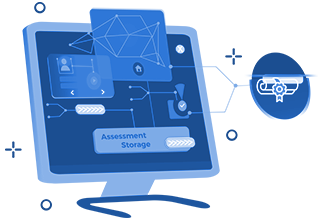There are thousands of non-degree-granting postsecondary institutions in Canada. Of these, over 150 are recognized public colleges and institutes. Many others are registered or licensed. Many more are not regulated in any way.
Non-degree-granting institutions focus on diploma and certificate programs and may also provide degree or joint diploma/degree courses.
Depending on the province or territory, public non-degree-granting institutions are called colleges, regional colleges, centres, colleges of applied arts and technology, community colleges, institutes, or CÉGEPs. They offer educational programming in a wide range of settings, from large urban centres to remote and isolated communities. Colleges are found in over 900 communities in Canada. Facilities vary from large, well-equipped institutions to small training centres. Almost all jurisdictions offer college programs in both French and English, whether through dedicated colleges, specialized institutes, or extensive distance-education opportunities.
Private non-degree-granting institutions may be called colleges, career training institutes, vocational schools, or academies, depending on whether the province or territory in which they are located has legislated title restrictions. Most operate as businesses to deliver highly focused, occupationally oriented courses and programs.
Teaching and Research
Non-degree-granting institutions are primarily teaching institutions, employing over 46,000 full-time and almost 60,000 part-time faculty members in 2007. Colleges' and institutes' applied research, development, and technology diffusion focus on market needs, technology transfer, new processes, and prototypes, all with solid applications to economic development.
While many instructors at public non-degree-granting institutions hold doctoral degrees, relevant professional experience in technical or vocational fields is an important criterion for hiring teachers. In addition to regular teaching staff, part-time instructors are drawn from industry, secondary schools, universities, professional fields, and health and social services.
Administration and Governance
Public colleges, specialized institutes, community colleges, institutes of technology and advanced learning, colleges of applied arts and technology, and CÉGEPs may be more closely regulated than universities. Most have boards of governors appointed by provincial or territorial governments, with student, faculty, and community representation. Government intervention can extend to admission policies, program approval, curricula, institutional planning, and working conditions. Program planning tends to rely on input from community, business, industry, and labour representatives serving on college advisory committees, with overall direction provided by college administrators. Programs are generally organized into schools, divisions, or departments.
In most provinces, private non-degree-granting institutions must follow legislated registration or licensing procedures in order to operate.
Programs
Public colleges, specialized institutes, community colleges, institutes of technology and advanced learning, and CÉGEPs offer vocationally oriented programs in a wide range of professional and technical fields, including business, health, science, agriculture, applied arts, technology, skilled trades, and social services. Some specialized institutes offer training in a single field, such as art, fisheries, paramedical technology, or agriculture. As mentioned above, many also offer bachelor's and applied degree programs.
In addition, these institutions often provide adult basic-education and literacy programs; adult retraining, customized training for industry, professional upgrading, pre-employment, and pre-apprenticeship programs; and workshops. Many colleges also offer specialized postgraduate diplomas to students who already have a diploma or degree.
Diplomas are generally awarded for the successful completion of two- or three-year programs, while certificate programs most often take one year to complete. CÉGEPs in Quebec offer two-year academic programs required for university entrance and three-year technical programs for labour-market entry.
Several college systems offer university transfer programs, providing the first two years of a university undergraduate program. Universities and colleges also cooperate on integrated programs for which graduates receive both a degree and a diploma. Cooperative education is part of many programs, with work placements being a requirement in addition to academic study.
Programs at private non-degree-granting postsecondary institutions tend to be shorter and more intensive than programs in public institutions. These private institutions usually award certificates and diplomas.
Apprenticeship is an industry-driven program that has established training and certification standards in more than 50 designated trades and occupations. Employers support the program by employing apprentices and giving them the opportunity to develop their skills on the job. Colleges offer the in-class portion of apprenticeship programs, providing up to eight weeks of class instruction in each year of the apprenticeship. The length of apprenticeship programs differs by trade, but is usually four years, with graduation resulting in a certificate.
With close ties to communities and considerable flexibility in program design, course delivery, and the hiring of teaching staff, colleges have shown themselves adept at responding quickly to changing educational and training requirements.
About 80 per cent of colleges provide credit for prior learning assessment and recognition (PLAR) in at least some of their programs. Some universities also employ PLAR, which helps adults demonstrate and gain recognition for learning acquired outside of formal academic settings.
Student services are an important component of college offerings; these include academic, employment, personal, financial, diversity and anti-discrimination counselling, tutoring, daycare, health, English or French second-language training, and learning-skills development.
To provide wider access to their programs, colleges in many provinces have formed consortia to offer a variety of technical, vocational, and academic credit and non-credit courses by alternative means. Distance education is available from numerous individual institutions as well. The technologies used and the clients served are similar to those for degree-granting institutions.
Most colleges offer programs on a two-year or a three-semester basis. They also provide a wide range of credit and non-credit day and evening courses, both on and off campus, throughout the year. Study periods at private non-degree-granting institutions tend to be measured in weeks and semesters, rather than in years.
Admission Requirements
Non-degree-granting institutions set their own entrance requirements, which may be more flexible than those of universities. However, in general, secondary-school graduation is required for technical and professional diploma programs, as well as for pre-university transfer programs. Since accessibility is part of the mandate for most public colleges, many admission standards include more flexible criteria for mature students. High-demand programs may have more rigorous admission requirements.
Many private postsecondary institutions base their entrance requirements on a student's capacity to pay the required fees, although academic standing can be important as well.
Tuition Fees
Annual tuition fees for public colleges and institutes vary widely across the country, with the average being about $2,400 in 2007–08. The exception is Quebec, where residents pay no fees to enrol in a public college or CÉGEP on a full-time basis.
For international students, fees can be considerably higher, although circumstances vary widely across the country.
Fees at private non-degree-granting institutions tend to be higher than those at public institutions.
 English
English Français
Français 日本語
日本語 中文
中文 한국어
한국어 Русский
Русский










